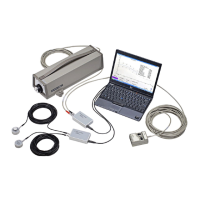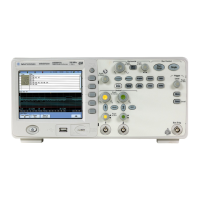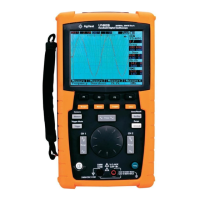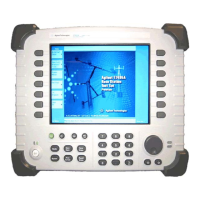30 5000 Series Oscilloscopes Service Guide
2 Testing Performance
3 Set up the oscilloscope.
a Press the Save/Recall key, then press the Default Setup
softkey.
b Press the Acquire key; then, press the Realtime softkey to
deselect Realtime.
c Press the Acq Mode softkey until Averaging is selected.
Then, press the #Avgs softkey and turn the Entry knob to
set the number of averages to 8.
d Set channel 1 Imped to 50 Ohm.
e Set the time base to 500 ns/div.
f Set the Volts/Div for channel 1 to 200 mV/div.
4 Set the signal generator for 1 MHz and six divisions of
amplitude.
The signal on the oscilloscope screen should be about five
cycles at six divisions amplitude.
5 Set up the Amplitude measurement
a Press the Quick Meas key.
b Press the Clear Meas softkey.
c Press the Select: softkey and use the Entry knob to select
Std Deviation within the select menu.
d Press the Measure Std Dev softkey.
6 Note the oscilloscope Std Dev(1) reading at the bottom of the
screen. (This is the RMS value with any dc offset removed.)
7 Set the power meter Cal Factor % to the 1 MHz value on the
calibration chart on the power sensor.
8 Note the reading on the power meter and covert to Vrms
using the expression:
For example, if the power meter reading is 892 uW, then
Vin
1MHz
= (892*10
-6
* 50Ω)
1/2
= 211.2 mV
rms
.
9 Change the signal generator output frequency according to
the maximum frequency for the oscilloscope using the
following:
in
1
MHz
Ω×= 50
1MHz
Pmeas
